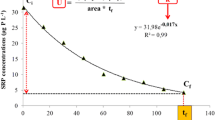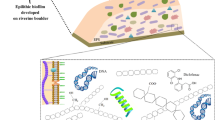Abstract
Metal wastes can significantly disturb aquatic communities, particularly photosynthetic organisms, the main primary producers in freshwater running ecosystems. In this study, biofilms and diatoms were used as bioindicators to characterize the kinetics of biofilm recovery. An experimental decontamination study was conducted under laboratory conditions, after biofilm colonisation at a site subject to discharge of industrial metals (Zn and Cd) and in parallel at an upstream site, metal-free, considered as a control. After 24 days of colonisation, biofilms were translocated and maintained in the laboratory for 56 days under clean conditions (control and decontamination) or metal contamination. Various tests were conducted from the community level—measures of metal bioaccumulation, cell densities and taxonomic investigations, to the individual level—measures of teratological forms. After 56 days of decontamination, Zn and Cd concentrations in decontaminated biofilms showed a sharp decline, respectively ranging from 6.7 ± 2 to 4 ± 2.5 mg Zn g−1 DW and from 207.6 ± 24.5 to 45.4 ± 9.9 μg Cd g−1 DW. However, at the end of the experiment bioaccumulations remained significantly higher than concentrations in control biofilms. Despite a diatom evolution in biofilm assemblages, taxonomic inventories did not demonstrate a complete restoration of diatom communities in biofilms under decontamination conditions compared with controls, since metal-resistant species initially present after colonisation at the contaminated site, such as Eolimna minima, persisted in high abundance in decontaminated biofilms. Biofilms kept under metal pressure showed very high bioaccumulation capacities and a sharp decline of species diversity which allowed identification of some resistant species. Regarding these first results on the behaviour of diatom biofilms under experimental decontamination conditions, improvement of the natural hydrosystem’s chemical state appears quickly, but an eventual return to good ecological status appears delayed, with the persistence of metal-tolerant species even after 56 days.



Similar content being viewed by others
Explore related subjects
Discover the latest articles, news and stories from top researchers in related subjects.References
Bérard A, Dorigo U, Mercier I, Becker-van Slooten K, Grandjean D, Leboulanger C (2003) Comparison of the ecotoxicological impact of the triazines Irgarol 1051 and atrazine on microalgal cultures and natural microalgal communities in Lake Geneva. Chemosphere 53(8):935–944
Brand LE, Murphy LS, Guillard RRL, Ht Lee (1981) Genetic variability and differentiation in the temperature niche component of the diatom Thalassiosira pseudonana. Mar Biol 62(2–3):103–110
Cattaneo A, Asioli A, Comoli P, Manca M (1998) Organisms’ response in a chronically polluted lake supports hypothesized link between stress and size. Limnol Oceanogr 43(8):1938–1943
Cattaneo A, Couillard Y, Wunsam S, Courcelles M (2004) Diatom taxonomic and morphological changes as indicators of metal pollution and recovery in Lac Dufault (Québec, Canada). J Paleolimnol 32(2):163–175
Coste M, Boutry S, Tison-Rosebery J, Delmas F (2008) Improvements of the biological diatom index (BDI): description and efficiency of the new version (BDI-2006). Ecol Indic 9(4):621–650
Coynel A, Schafer J, Dabrin A, Girardot N, Blanc G (2007) Groundwater contributions to metal transport in a small river affected by mining and smelting waste. Water Res 41(15):3420–3428
Dauta A, Brunei L, Guerri MM (1982) Détermination expérimentale, des paramètres liés à l’assimilation de l’azote et du phosphore par Scenedesmus crassus. Ann Limnol 18:33–40
Dorigo U, Bourrain X, Bérard A, Leboulanger C (2004) Seasonal changes in the sensitivity of river microalgae to atrazine and isoproturon along a contamination gradient. Sci Total Environ 318(1–3):101–114
Dorigo U, Lefranc M, Leboulanger C, Montuelle B, Humbert JF (2009) Spatial heterogeneity of periphytic microbial communities in a small pesticide-polluted river. FEMS Microbiol Ecol 67(3):491–501
Dorigo U, Berard A, Rimet F, Bouchez A, Montuelle B (2010) In situ assessment of periphyton recovery in a river contaminated by pesticides. Aquat Toxicol 98(4):396–406
Duong TT, Morin S, Herlory O, Feurtet-Mazel A, Coste M, Boudou A (2008) Seasonal effects of cadmium accumulation in periphytic diatom communities of freshwater biofilms. Aquat Toxicol 90(1):19–28
Duong TT, Morin S, Coste M, Herlory O, Feurtet-Mazel A, Boudou A (2010) Experimental toxicity and bioaccumulation of cadmium in freshwater periphytic diatoms in relation with biofilm maturity. Sci Total Environ 408(3):552–562
Falasco E, Bona F, Ginepro M, Hlùbikovà D, Hoffmann L, Ector L (2009) Morphological abnormalities of diatom silica walls in relation to heavy metal contamination and artificial growth conditions. Water SA 35(5):595–606
Fang HHP, Xu LC, Chan KY (2002) Effects of toxic metals and chemicals on biofilm and biocorrosion. Water Res 36(19):4709–4716
Feurtet-Mazel A, Gold C, Coste M, Boudou (2003) A study of periphytic diatoms communities exposed to metallic contamination through complementary field and laboratory experiments. J Phys IV 107(1): 467–470
Gélabert A, Pokrovsky OS, Schott J, Boudou A, Feurtet-Mazel A (2007) Cadmium and lead interaction with diatom surfaces: a combined thermodynamic and kinetic approach. Geochim et Cosmochim Acta 71(15):3698–3716
Granetti B (1968) Comportamento Di Un Carattere Teratologico Comparso in Navicula Minima Grun. G Bot Italiano 102(6):507–513
Hynynen J, Palomäki A, Meriläinen JJ, Witick A, Mäntykoski K (2004) Pollution history and recovery of a boreal lake exposed to a heavy bleached pulping effluent load. J Paleolimnol 32(4):351–374
Ivorra N, Hettelaar J, Tubbing GMJ, Kraak MHS, Sabater S, Admiraal W (1999) Translocation of microbenthic algal assemblages used for in situ analysis of metal pollution in rivers. Arch Environ Contam Toxicol 37(1):19–28
Kim Tiam S, Feurtet-Mazel A, Delmas F, Mazzella N, Morin S, Daffe G, and Gonzalez P (2012) Development of q-PCR approaches to assess water quality: effects of cadmium on gene expression of the diatom Eolimna minima. Water Res. doi:10.1016/j.watres.2011.11.005
Krammer K, Lange-Bertalot H (1986/1991) Bacillariophyceae 1. Teil: Naviculaceae. 876 p.; 2. Teil: Bacillariaceae, Epithemiaceae, Surirellaceae, 596 p.; 3. Teil: Centrales, Fragilariaceae, Eunotiaceae, 576 p.; 4. Teil: Achnanthaceae. Kritische Ergänzungen zu Navicula (Lineolatae) und Gomphonema. G. Fischer Verlag, Stuttgart, p 437
Lacaze E, Devaux A, Mons R, Bony S, Garric J, Geffard A, Geffard O (2011) DNA damage in caged Gammarus fossarum amphipods: a tool for freshwater genotoxicity assessment. Environ Pollut 159(6):1682–1691
Lavoie I, Hamilton PB, Campeau S, Grenier M, Dillon PJ (2008) Guide d’identification des diatomées des rivières de l’Est du Canada, Québec
Lavoie M, Le Faucheur S, Fortin C, Campbell PGC (2009) Cadmium detoxification strategies in two phytoplankton species: metal binding by newly synthesized thiolated peptides and metal sequestration in granules. Aquat Toxicol 92(2):65–75
Lecointe C, Coste M, Prygiel J (1993) Omnidia—software for taxonomy, calculation of diatom indexes and inventories management. Hydrobiologia 269:509–513
McCormick PV, Cairns J (1994) Algae as indicators of environmental-change. J Appl Phycol 6(5–6):509–526
Meylan S, Behra R, Sigg L (2004) Influence of metal speciation in natural freshwater on bioaccumulation of copper and zinc in periphyton: a microcosm study. Environ Sci Technol 38(11):3104–3111
Morin S, Duong TT, Herlory O, Feurtet-Mazel A, Coste M (2007) Cadmium toxicity and bioaccumulation in freshwater biofilms. Arch Environ Contam Toxicol 54(2):173–186
Morin S, Pesce S, Tlili A, Coste M, Montuelle B (2009) Recovery potential of periphytic communities in a river impacted by a vineyard watershed. Ecol Indic 10(2):419–426
Pokrovsky O, Martinez R, Feurtet-Mazel A, Morin S, Baudrimont M, Duong T, Coste M (2010) Experimental study of cadmium interaction with periphytic biofilms. Appl Geochem 25:247–418
Pusch M, Fiebig D, Brettar I, Eisenmann H, Ellis BK, Kaplan LA, Lock MA, Naegeli MW, Traunspurger W (1998) The role of micro-organisms in the ecological connectivity of running waters. Freshw Biol 40(3):453–495
Reavie ED, Jicha TM, Angradi TR, Bolgrien DW, Hill BH (2009) Algal assemblages for large river monitoring: comparison among biovolume, absolute and relative abundance metrics. Ecol Indic 10(2):167–177
Sanders JG, Cibik SJ (1988) Response of Chesapeake Bay phytoplankton communities to low levels of toxic substances. Mar Pollut Bull 19(9):439–444
Shannon CE, Weaver W (1949) The mathematical theory of communication, vol III. University of Illinois Press, Urbana
Sommer U (1981) The role of r- and K-selection in the succession of phytoplankton in Lake Constance. Acta Oecol Gener 2:327–342
Stevenson RJ, Peterson CG (1989) Variation in benthic diatom (Bacillariophyceae) immigration with habitat characteristics and cell morphology. J Phycol 25(1):120–129
Stevenson RJ, Peterson CG (1991) Emigration and immigration can be important determinants of benthic diatom assemblages in streams. Freshw Biol 26(2):279–294
Tlili A, Corcoll N, Bonet B, Morin S, Montuelle B, Bérard A, Guasch H (2011) In situ spatio-temporal changes in pollution-induced community tolerance to zinc in autotrophic and heterotrophic biofilm communities. Ecotoxicology 20(8):1823–1839
Ueshima M, Ginn BR, Haack EA, Szymanowski JES, Fein JB (2008) Cd adsorption onto Pseudomonas putida in the presence and absence of extracellular polymeric substances. Geochim et Cosmochim Acta 72(24):5885–5895
Wood AM, Leatham T, Manhart JR, McCourt RM (1992) The species concept in phytoplankton ecology. J Phycol 28(6):723–729
Acknowledgments
This work was supported by the Agence Nationale de la Recherche (ANR) through its programme CES (Contamination Ecosystèmes Santé) under the reference ANR 08-CES-014 and developed in the RE-SYST project. The authors would like to thank Véronique Duflo, Henri Bouillard, from the EPOC laboratory, and Soizic Morin from the Cemagref/Irstea laboratory, for their support in field work, and Muriel Bonnet and Maryse Boudigues from the Cemagref/Irstea laboratory for the nutrient analyses.
Author information
Authors and Affiliations
Corresponding author
Rights and permissions
About this article
Cite this article
Arini, A., Feurtet-Mazel, A., Maury-Brachet, R. et al. Recovery potential of periphytic biofilms translocated in artificial streams after industrial contamination (Cd and Zn). Ecotoxicology 21, 1403–1414 (2012). https://doi.org/10.1007/s10646-012-0894-3
Accepted:
Published:
Issue Date:
DOI: https://doi.org/10.1007/s10646-012-0894-3




